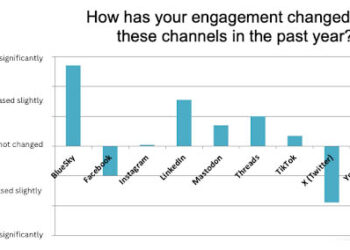
Webinars have become a go-to solution for many organizations seeking to reach an audience and diversify their program offerings. Webinars aren’t terribly expensive to create, they don’t force participants to travel or stay in hotels, and they can be stored for on-demand playback later, making them somewhat asynchronous. And they are proliferating at a rapid pace.
SSP has started a strong webinar series, and more are planned. Appeals to attend webinars decorate most in-boxes during any given week. My organization (STRIATUS/JBJS) has been ramping up webinar activities since a strong proof of concept for the orthopaedic audience last fall, and this fall we have 3-4 planned. I recently spoke at a meeting that was also a webinar for remote participants.
Webinars can take many forms, whether they are business-to-business or business-to-consumer. From single-speaker to a panel to a set of talks and commentaries, the format is fairly accommodating. Webinars can serve a variety of goals, and target different audience segments, some very small. Many webinars are free to attend. Some require participants to pay.
Because webinars are now so common, it’s becoming more important to evaluate their effectiveness. If a webinar attracts 30, 300, or 3,000 attendees, was it effective? Did you meet your financial goals? Did you achieve your pedagogical goals?
When you’re putting a webinar together, the technology and marketing aren’t the biggest challenges. Logistics and scheduling are. Speakers can be in various time zones, even halfway around the world (in one recent case for us, the international date line introduced confusion as it was unclear all the speakers could participate on the same day — turns out they could, once we realized that “Tuesday” to one of them meant Monday for the rest, an interesting semantic problem that resisted attempts at clarification for a good while). At the meeting/webinar where I recently spoke, I traveled to the venue, while the majority of attendees remained in their offices. They could not share in the joy of missing the Acela and being forced to drive through Connecticut. In this case, the logistical burden was travel for the speaker.
Webinars can be more demanding for speakers for other reasons. Some are tightly choreographed to fit into a one-hour timeframe. Speakers have to prepare their presentations early in these cases, and often go through a dress rehearsal of sorts, so that the entire slate of speakers can work together once and eliminate problems that might occur were the group to try it cold. This adds to the time and effort involved in speaking via webinar, while also doubling the scheduling problems (you have to schedule the dress rehearsal for everyone, as well).
Variability around local technology for speakers and attendees can also pose challenges. Speakers may have to participate from hotel rooms, where the Internet can be spotty or unexpectedly clog when everyone checks their email before going to sleep. Computers can have various camera and speaker configurations. Telephones vary in quality. Ambient noise (sirens, parties next door, housekeeping knocking on the door) can interfere. And speakers can vary in awareness and sophistication, as anyone who has had a “phone breather” on the line can attest.
Believe it or not, but weather can play a role in webinars. Our first webinar was dramatically affected by Superstorm Sandy, as it swept across the Northeast, forcing our staff lead to change her plans for managing the event and cutting our audience for the live portion down to some extent. It’s easy to imagine weather causing problems in the future — with servers, local connectivity, phones used by speakers, or the ability of speakers to be where they’d planned to be (travel delays).
Part of the appeal of webinars is that they have low variable costs, while their fixed costs don’t usually compound. It can take a lot of staff time and effort to pull them off, but you usually are reducing work on other things (meetings or publications) and redirecting it to webinars. Staff initially find working on webinars interesting and exciting. But the variable costs are not zero, and the honeymoon period around webinars is certainly not limitless. Soon, it becomes just another job.
As webinars proliferate and inevitably compete, the question will arise, both around individual initiatives and suites of initiatives: “Is this worth it?”
The unsatisfactory honest answer is, “It depends.”
Webinars can match some organizational goals well. They can provide strong niche marketing connections. Used purely for internal purposes, they can help one group train another across distances, such as when the trainer group is small and the trainee group is large (e.g., editorial boards training peer-reviewers). They can help bring attention to an emerging or hot topic, allowing experts to consolidate evidence and opinion into compelling short presentations without the pressure of publishing a peer-reviewed article (or the audience being forced into the structure and language of a peer-reviewed article). They can make an organization look more modern, something that can be important to organizations worrying they appear fusty and old-fashioned to their younger members. Webinars can show off the “big names” organizations can bring to a topic, underscoring prestige. Combine any two of these, or choose from maybe a half-dozen other reasons to give webinars a shot, and you may want to host a webinar.
If advertisers or others sponsor webinars, or publishers can offer paid continuing education credits available for attendees, the value calculation can be more concrete — simple profit and loss. Some webinars charge attendees straightaway, but these are few and far between.
There are risks to going into the webinar business without a plan. These risks include opportunity costs. Perhaps the biggest risk is a hidden cost:benefit calculation that has to be made. The burden of scaling up a webinar seems to fall mostly on staff. And the risk to staff is real — putting together webinars is demanding work and can lead to fatigue if there are too many back-to-back or there is no “team” assigned. We’ve expanded our team so that editorial staff are involved in helping to recruit and coordinate editors as speakers, and have spread some of the marketing and editorial work around. Our webinar champion could do it all, but we don’t want to burn her out. At some point, we may have to reexamine support if webinars continue to proliferate. It may be a line of business. That will be a different plan.
Where is the saturation point for webinars? It has two sides — the audience’s appetite and the producer’s benefit from putting them together. Given the amount of work required to assemble them, and the modest benefit currently accruing to organizations through webinars, I think they will continue to be a part of the mix, but not a dominant part. I’m glad we have them, they can reach key slices of an audience, and they can take the place of some meetings. However, trends working against travel budgets and time away from the office and home — cost and lifestyle choices — may allow webinars to continue to grow consistently over the next few years.
If they do, what is your place in that? What is your plan?
Discussion
5 Thoughts on "Webinars, Webinars, Webinars — How Do We Evaluate This New and Increasingly Pervasive Option?"
I was about to moderate my second webinar for CSE when the Great Earthquake hit northern Virginia. There was confusion about whether my building was being evacuated. Thanks to having a “dress rehearsal” others were able to start the webinar while I was standing on the front lawn of the building.
Technical issues and poorly prepared presenters are my biggest pet peeves on webinars. It is very frustrating when it is obvious that there was no practice run. I have attended many good webinars (paid and free) and many terrible webinars (paid and free).
The hardest part about speaking via webinar is that you get ZERO audience feedback and that takes some getting used to.
We are doing our first editor training via webinar later this week. With hundreds of associate editors that need to be trained on a new policy, setting up a PPT and three webinar times for them to dial in may be the best way to reach this audience.
Apparently I am a luddite. I routinely trash all the e-mails I get about webinars, no matter the source, except the ones from one funding agency that requires participation in periodic webinars as a condition of their funding. Otherwise, life is just too short…
(P.S.: I am a P.I. of a research lab’ in academic biosciences, not in the USA
I agree with the “zero feedback” comment above. When you do a webinar, you really are like the radio or TV to the attendees, and they will definitely tune you out. That could be a good thing in the respect that it forces the presenter to be concise and to refrain from the routine careless boring that a lot of speakers will do in an in-person format. It’s also probably a bad thing because at some point the number of distractions you’re competing with can really shut down even the most skillful effort to impart necessary information. If a webinar is broadcast in the middle of a forest of information, does it make a sound? It’s a conundrum.
Not sure if this is following the short form of our kids’ video world, but I’m finding that 60-minutes is way too long for the average professional to attend or at least focus while other daily demands build up. My recent experience is that 30 minutes or less seems to be a more well-reviewed format with higher registration turnouts as well. As for the feedback challenge, the options include pre-webinar questions (closed and open-ended), on air real-time surveys, live chat questions (which require introduction at the beginning), and post-event surveys particularly on the last screen.
We have organized a few webinars in the past few months, with mixed responses. From my experience, thematic-based webinars, such as writing clinical case reports and getting your papers published in international journals are well received. The key challenges are time constraints and the pressure to reach out to the right target audiences while ensuring that they attend the live event after registration. The on-demand video is useful to follow up with those who cannot make it for the live event. We find that webinars help us to generate qualify sales leads and establish our thoughts leadership. You can find out more about our webinars in our blog at http://wileyasiablog.com/resources/wileys-webinar-series-for-researchers/


